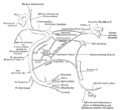Cervical branch of the facial nerve
Cervical branch of the facial nerve
The cervical branch of the facial nerve is a significant peripheral nerve of the head and neck region. It is a branch of the facial nerve (cranial nerve VII), which is crucial for facial expression, among other functions. The cervical branch specifically innervates the platysma muscle, playing a pivotal role in facial expressions related to the lower face and neck.
Anatomy[edit]
The facial nerve, or cranial nerve VII, emerges from the brainstem between the pons and the medulla. It traverses the internal acoustic meatus to enter the facial canal within the temporal bone, giving rise to several branches, including the cervical branch. This particular branch exits the stylomastoid foramen and descends to innervate the platysma muscle, a broad, thin muscle in the superficial layer of the anterior neck.
Function[edit]
The primary function of the cervical branch of the facial nerve is motor innervation to the platysma muscle. The platysma is involved in lowering the lower lip and angle of the mouth, which is crucial for expressions of sadness or fright. It also contributes to the tension of the skin in the neck, aiding in the expression of surprise or alarm.
Clinical Significance[edit]
Damage to the cervical branch of the facial nerve can result in an asymmetrical facial appearance due to paralysis of the platysma muscle. This may manifest as an inability to depress the lower lip or create skin tension in the neck. Such damage is often a result of surgical procedures in the neck region, trauma, or pathological conditions affecting the facial nerve.
Bell's palsy, a condition that causes sudden, temporary weakness or paralysis of the facial muscles, can also affect the cervical branch, though its symptoms are more commonly associated with the upper branches of the facial nerve.
Diagnosis and Treatment[edit]
Diagnosis of cervical branch dysfunction typically involves a combination of clinical examination and imaging studies, such as MRI or CT scans, to assess the extent of nerve damage. Electromyography (EMG) can also be used to evaluate the electrical activity of the platysma muscle.
Treatment options vary depending on the cause and extent of the nerve damage. In cases of Bell's palsy, corticosteroids or antiviral medications may be prescribed. Physical therapy exercises can help in restoring muscle function. Surgical intervention may be considered in cases of severe trauma or when nerve damage is irreversible.
See Also[edit]
Cervical branch of the facial nerve[edit]
-
Cervical branch of the facial nerve
-
Cervical branch of the facial nerve
-
Cervical branch of the facial nerve
-
Cervical branch of the facial nerve
-
Cervical branch of the facial nerve
Ad. Transform your life with W8MD's Budget GLP-1 injections from $75


W8MD offers a medical weight loss program to lose weight in Philadelphia. Our physician-supervised medical weight loss provides:
- Weight loss injections in NYC (generic and brand names):
- Zepbound / Mounjaro, Wegovy / Ozempic, Saxenda
- Most insurances accepted or discounted self-pay rates. We will obtain insurance prior authorizations if needed.
- Generic GLP1 weight loss injections from $75 for the starting dose.
- Also offer prescription weight loss medications including Phentermine, Qsymia, Diethylpropion, Contrave etc.
NYC weight loss doctor appointmentsNYC weight loss doctor appointments
Start your NYC weight loss journey today at our NYC medical weight loss and Philadelphia medical weight loss clinics.
- Call 718-946-5500 to lose weight in NYC or for medical weight loss in Philadelphia 215-676-2334.
- Tags:NYC medical weight loss, Philadelphia lose weight Zepbound NYC, Budget GLP1 weight loss injections, Wegovy Philadelphia, Wegovy NYC, Philadelphia medical weight loss, Brookly weight loss and Wegovy NYC
|
WikiMD's Wellness Encyclopedia |
| Let Food Be Thy Medicine Medicine Thy Food - Hippocrates |
Medical Disclaimer: WikiMD is not a substitute for professional medical advice. The information on WikiMD is provided as an information resource only, may be incorrect, outdated or misleading, and is not to be used or relied on for any diagnostic or treatment purposes. Please consult your health care provider before making any healthcare decisions or for guidance about a specific medical condition. WikiMD expressly disclaims responsibility, and shall have no liability, for any damages, loss, injury, or liability whatsoever suffered as a result of your reliance on the information contained in this site. By visiting this site you agree to the foregoing terms and conditions, which may from time to time be changed or supplemented by WikiMD. If you do not agree to the foregoing terms and conditions, you should not enter or use this site. See full disclaimer.
Credits:Most images are courtesy of Wikimedia commons, and templates, categories Wikipedia, licensed under CC BY SA or similar.
Translate this page: - East Asian
中文,
日本,
한국어,
South Asian
हिन्दी,
தமிழ்,
తెలుగు,
Urdu,
ಕನ್ನಡ,
Southeast Asian
Indonesian,
Vietnamese,
Thai,
မြန်မာဘာသာ,
বাংলা
European
español,
Deutsch,
français,
Greek,
português do Brasil,
polski,
română,
русский,
Nederlands,
norsk,
svenska,
suomi,
Italian
Middle Eastern & African
عربى,
Turkish,
Persian,
Hebrew,
Afrikaans,
isiZulu,
Kiswahili,
Other
Bulgarian,
Hungarian,
Czech,
Swedish,
മലയാളം,
मराठी,
ਪੰਜਾਬੀ,
ગુજરાતી,
Portuguese,
Ukrainian





